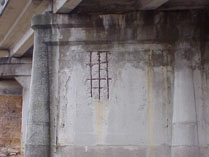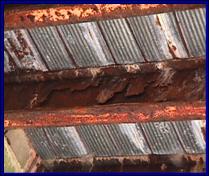 |
 |
|
Loss of Concrete Cover
|
Corroding Steel Girders
|
Overview: An aging infrastructure system throughout the United States represents major financial and operational concerns that must be addressed in the coming decades. In particular, the highway bridge component (approximately 600,000 bridges) of this infrastructure represents a major investment that is vital to the economy, constantly in use, and subject to various long and short term deterioration mechanisms. Due to their heavy use, these bridges are periodically inspected to insure public safety. However, current inspection procedures are subjective in nature and may not provide the entire spectrum of information required for accurate condition assessment. Also, this infrastructure component is constantly under repair, maintenance, rehabilitation, and upgrade in addition to the construction of new facilities. These different functions may serve to facilitate safety, operational performance, or both. Due to the large investment of resources that has already been made, as well as public safety and economic considerations, the ability to understand long-term bridge performance is very important as are efficient methods in which to manage their operation.
Research at Vanderbilt University is addressing the understanding of long-term bridge performance and management. The overall objective of this research is to advance highway bridge inspection procedures from current subjective methods to a more quantitative, objective framework for assessment and inspection. Coupled with this advancement will be better understanding and prediction capability of long term bridge performance. This will be accomplished through the integration of quantitative data, models, and inspection techniques with current inspection practices. Considering this objective, the following tasks have been identified and are currently under investigation: (1) Definition of sample bridges representative of those present throughout the country and development of a framework for identifying the different bridge types and their respective components that will be of interest when studying long-term performance, (2) Augmentation of existing condition states with quantitative treatment for more accurate assessment of bridge condition, (3) Comprehensive identification of the deterioration processes that limit the service life and performance of highway bridges as well as the relationships between physical bridge characteristics and operational performance, (4) Assessment of the current quantitative deterioration and operational performance model inventory, identification of gaps in the model inventory, and quantification of parameters required for model use, (5) Identification and assessment of available methods for acquiring data for use with deterioration and operational models, and (6) Development of inspection checklists for the bridge structures that remain operational and autopsy checklists for bridges that may be de-commissioned and made available for testing.
 |
 |
|
Loss of Concrete Cover
|
Corroding Steel Girders
|
©